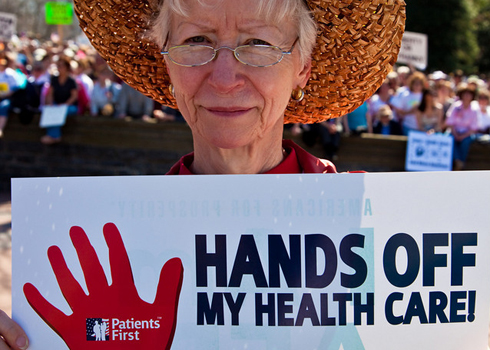In reclaiming the House last November, Republicans framed their victory as a clear mandate from the American people to scrap ‘Obamacare.’ A cursory scan of the polling data suggests they were right, with some polls pegging support for repeal as high as 60%.
Yet a closer examination of the numbers reveals that the claim is considerably overblown.
The primary problem with polling data on the issue is that surveys tend to oversimplify the debate. Many polls present respondents with just two options: repeal the whole shebang, or do nothing at all. What those polls fail to take into account is the fact that some parts of the law are widely popular, while others are disliked, and still others are unknown or misunderstood.
For example, a CNN poll from December found broad support for the law’s main provisions — except the much maligned individual mandate. Sixty percent of respondents said they opposed the individual mandate, though larger percentages supported the provisions preventing insurers from denying coverage based on preexisting conditions (64%) or dropping coverage for those who become seriously ill (61%.)
All or nothing polls tend to exaggerate support for a full repeal by counting respondents who may only dislike one part of the comprehensive law.
Rasmussen is perhaps the biggest culprit here, as they ask a direct repeal or no repeal question and allow respondents to say only whether they “strongly” or “somewhat” fall to either side. By that measure, Rasmussen pegged support for repeal at 60% in mid December, with just 34% opposing repeal. (Rasmussen has been criticized in the past, notably by Nate Silver, for using methodology that may create biased results.)
When more nuanced wording is used, the picture changes drastically.
As Greg Sargent noted earlier this week, a great example of this is the latest ABC/Washington Post poll, which first asked respondents if they supported or opposed the law, and then asked those who opposed or had no opinion of the law if they favored a full or partial repeal. When the results of that breakdown were factored back into the whole sample, less than one in five (18%) favored a full repeal, while more people (19%) favored a partial repeal.
That poll isn’t alone. In fact, two polls have actually found a seemingly counterintuitive result, given the supposed high support for a total repeal.
A recent AP-GFK poll pegged support for the law at 40%, with opposition slightly higher at 41%. But when they asked if respondents would like to expand, trim, or scrap the law, or to leave it as is, a whopping 43% said they’d like to see the law do more to change the health care system. Meanwhile, 26% said they’d want it repealed entirely, and 10% said they’d prefer to see it scaled back. Similarly, when Marist presented respondents with the same options, 35% said they wanted the law to do more, while 30% wanted it repealed entirely.
A quick look at the TPM Poll Average greatly underscores this point. With all polls factored in, support for full repeal trumps opposition, 50% to 43.4%.
[Late Update: Since this post was published Friday morning, new polls have been entered in TPM PollTracker, which has changed the TPM Poll Average. The text of this post hasn’t been changed, but the numbers in the graphs below reflect the new polls.]
But when Rasmussen is filtered out, the opposite is true, with opposition to repeal coming out on top 46.5% to 45.5%.
Rasmussen polls the question far more regularly than anyone else, which skews the average toward their finding.
Despite full-throated assertions from some Republicans that the midterm elections were a complete repudiation of the health care law, that just doesn’t seem to be the case. So while the House successfully passed the “Repealing the Job Killing Health Care Law Act” on Tuesday, it looks like that wasn’t what Americans wanted them to do after all.






